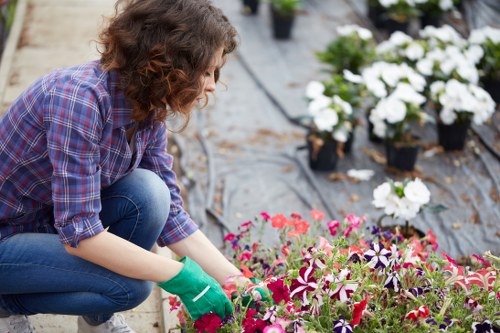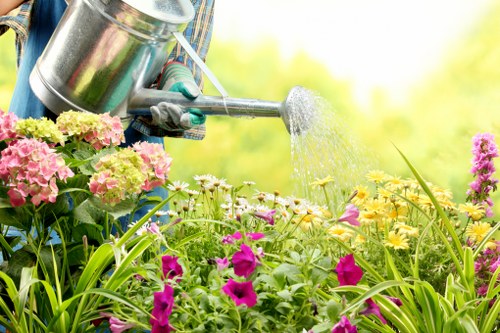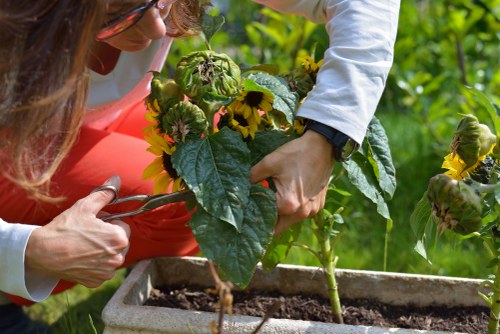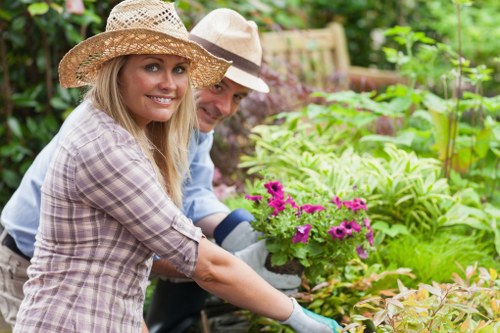Garden Maintenance Spitalfields: Cultivating Beauty and Community

Introduction
Garden maintenance in Spitalfields is more than just keeping a yard tidy—it is an art, a lifestyle, and a community passion. In this bustling area of London, every garden tells a story of creativity, hard work, and local pride. People who live here understand that a well-tended garden can transform an outdoor space into a sanctuary.
In Spitalfields, where history meets modernity, homeowners and businesses alike take pride in cultivating lush greens, colourful flower beds, and quiet retreats amid urban energy. Whether you are new to garden care or a seasoned green thumb, this article offers valuable insights on how to achieve a thriving garden with local touches.
We will explore essential maintenance techniques, eco-friendly practices, and how the neighbourhood’s distinct character influences garden care. Our goal is to provide useful tips and expert advice that can help everyone enjoy the benefits of a neat and healthy garden.

Why Garden Maintenance in Spitalfields Matters
Garden maintenance in Spitalfields is vital for preserving the area’s unique blend of history and modern living. Well-kept gardens not only enhance curb appeal but also contribute to the overall atmosphere of the neighborhood. With quality maintenance, gardens become spaces for relaxation, social gatherings, and personal expression.
Maintaining a garden in such a central area demands attention to detail. Due to the urban environment, challenges like limited space, pollution, and infrequent rainfall are common. However, locals have embraced these challenges and turned them into opportunities for creative landscaping and sustainable practices.
It is important to note that the practices used in Spitalfields are tailored to local conditions. This means that garden maintenance is not a one-size-fits-all approach; it is a specialized service that takes into account the climate, soil type, and the unique microclimate of London’s urban setting.

Balancing History and Modernity in Garden Care
One of the highlights of garden maintenance in Spitalfields is the way it merges traditional techniques with modern innovations. Heritage plant species are often nurtured alongside new, climate-resilient varieties. Homeowners take pride in preserving the history of their properties while enjoying contemporary garden technology.
Local garden experts blend classical design with progressive ideas, offering clients a chance to experiment while respecting history. This balance creates a living piece of art that evolves year after year.
It is common to see a mix of old-world charm with modern sustainable practices such as water conservation, composting, and organic pest control. This trend not only beautifies the area but also supports the local ecosystem.

Expert Tips and Techniques
When it comes to garden maintenance in Spitalfields, expert advice plays a crucial role. Here are some practical tips to keep your garden blooming and vibrant:
- Regular Pruning – Timely pruning helps remove dead parts and encourages healthy new growth.
- Watering Practices – A consistent watering schedule, especially during dry spells, is vital for plant health.
- Sustainable Fertilization – Use eco-friendly fertilizers to enhance soil quality while caring for the environment.
By following these techniques, your garden will not only thrive but also serve as an inviting retreat. Simple steps like mulching, weeding, and ensuring proper drainage can boost plant life significantly.

Seasonal Garden Maintenance
Spitalfields experiences all four seasons, which means your garden maintenance schedule must adapt accordingly. In the winter months, focus on protecting tender plants and preventing frost damage. Use natural barriers or covers to keep your green friends safe.
During spring, the garden comes alive with growth. This is the ideal time for planting, fertilizing, and paving the way for a colourful summer display. Pruning dead winter growth allows for more robust blooming.
In summer, the emphasis is on watering and managing heat stress. High temperatures require more frequent care, ensuring that even the smallest ferns and shrubs receive enough moisture to flourish.

Understanding the Local Landscape
Central to garden maintenance in Spitalfields is an understanding of its local landscape. The ancient roots of the area combined with modern architecture provide a unique backdrop for any outdoor space. Local residents cherish the old town charm while also embracing progress.
Gardens in Spitalfields often feature a mix of rockeries, raised flower beds, and even vertical gardens. These design elements are not only innovative but also highly functional in urban settings where ground space is limited.
Moreover, the use of native plants and heirloom seeds is gaining popularity, as they require less maintenance and are better adapted to the local climate. Such practices are environmentally friendly and reduce the need for chemical treatments.

DIY vs Professional Garden Maintenance
Many residents of Spitalfields enjoy tackling garden projects on their own. DIY garden maintenance can be a fulfilling hobby and an excellent way to personalize your outdoor space. It allows for experimentation, creativity, and a deeper connection with nature.
However, balancing DIY efforts with professional services may sometimes be necessary. Professional maintenance teams bring expertise and equipment that can tackle harder tasks like soil rejuvenation, pest control, and landscape design.
For those who may not have the time or specialized knowledge, consulting a professional service can ensure that your garden’s beauty is maintained all year round. Consider factors such as quality, reliability, and the company's familiarity with the local environment when making your decision.

Sustainable Practices in Garden Maintenance
Sustainability is a key component of modern garden maintenance. In Spitalfields, many residents and service providers are making a concerted effort to adopt eco-friendly practices. This includes organic gardening methods, water conservation, and the use of natural pesticides.
Organic composting is a great way to recycle garden waste into valuable nutrients that nourish your plants. By integrating compost into the soil, you boost its fertility without relying on chemical fertilizers.
Furthermore, the practice of rainwater harvesting and using drip irrigation systems can significantly reduce water waste while ensuring that your plants receive a steady and adequate supply.

The Role of Local Businesses
Local garden maintenance businesses in Spitalfields play a crucial role in keeping the area green and vibrant. These businesses not only provide services but also act as community partners in fostering a love for nature. Their expertise is honed by working in a unique urban environment, making them indispensable when it comes to understanding local soil, climate, and specific challenges.
Many companies pride themselves on offering personalized services with a strong emphasis on green practices. They often help educate homeowners on how to care for their own gardens, bridging the gap between professional expertise and DIY efforts.
Investing in local services supports the community and ensures that the unique character of Spitalfields is maintained. Engaging local experts means your garden benefits from years of accumulated knowledge and an intrinsic connection to the area.

Embracing Community Through Garden Maintenance
Community gardens are a growing trend in Spitalfields, bringing neighbours together to work on shared green spaces. These communal efforts foster a sense of belonging and encourage residents to work together towards a common goal.
Often, these gardens serve as a hub for educational workshops, volunteer activities, and social events. They promote a message of sustainability and shared responsibility, making garden maintenance a community-centric activity.
By joining forces in community gardening projects, neighbors benefit not only from enhanced green spaces but also from increased local engagement. It’s a win-win situation that adds value to both individual properties and the collective neighbourhood.

How to Get Started with Garden Maintenance
For beginners, starting your own garden maintenance routine can feel overwhelming. However, breaking the process down into manageable steps can make it much easier. Begin by assessing your outdoor space and identifying the areas that need the most attention.
Consider these steps as your road map: first, clear the area of debris and trim any overgrowth; second, prepare the soil with nutrient-rich compost; and third, choose plants that are suited to the local climate and sunlight conditions.
Remember, every garden is unique. The key is to take one step at a time and enjoy the process of seeing your space transform. With persistence and passion, even the smallest effort can yield fantastic results.

Essential Garden Tools and Accessories
Having the right tools can make all the difference in garden maintenance. A well-equipped toolbox should include basic tools such as pruning shears, spades, and a sturdy hose. Each item plays a role in ensuring that your garden care process is efficient and enjoyable.
Quality tools are designed to last and make work more comfortable. Investing in durable equipment is both time- and cost-effective in the long run. They reduce the strain on your body and help you achieve professional results.
Accessories like gloves, kneepads, and watering cans are also important, especially for those who spend a lot of time outdoors. Over time, these small investments improve your overall gardening experience and ensure that you can maintain your garden like a pro.

Tips for Sustaining Your Garden Over Time
Long-term garden care involves both regular maintenance and seasonal planning. One of the effective strategies is to create a maintenance calendar that outlines tasks for each season. This makes it easier to keep track of what needs to be done and when.
Additionally, rotating crops and updating your planting strategy based on seasonal changes can promote more robust growth. Keeping detailed notes about what works well in your garden can also help refine your approach over time.
Staying informed about local environmental changes, such as shifts in weather patterns or pests, is also crucial for adapting your maintenance routine. This proactive approach ensures that your garden remains resilient and continues to flourish year after year.

Local Relevance: Areas Near Spitalfields
Spitalfields is surrounded by a variety of vibrant neighbourhoods, each with its own character and charm. Understanding these local areas is essential in creating a garden maintenance strategy that reflects the spirit of the East End.
For instance, Shoreditch is known for its creative vibe and eclectic street art, influencing local gardening trends with bold colour and innovative plant pairings. The close proximity allows for a cross-pollination of ideas in garden design.
Bethnal Green offers a more relaxed pace and a strong sense of community. Gardeners here often focus on creating green spaces that serve as communal hubs, similar to the community gardens found in Spitalfields.

More Nearby Areas to Inspire Your Garden
Other neighbourhoods close to Spitalfields also contribute to the local garden culture:
- Whitechapel: A historic area offering a mix of cultural influences that are often reflected in garden layouts.
- Brick Lane: Famous for its creative energy, Brick Lane inspires vibrant, unconventional garden designs.
- Hoxton: A hub of modern living and creativity, contributing contemporary ideas to garden aesthetics.
Dalston brings an edgy, youthful vibe, encouraging gardeners to try out unusual arrangements and native planting strategies. Its energy fosters a love for resilience in garden care.
Mile End offers a balanced mix of urban lifestyle and green retreats. With ample community spaces, this area inspires both intricate design and simple, natural beauty.

Additional Local Influences and Neighbourhoods
Extending beyond the immediate vicinity, other nearby areas further enhance the local gardening scene. Canary Wharf might be known for its skyscrapers, yet its green spaces are meticulously maintained, providing a clear example of blending urban environments with nature.
The City of London emphasizes formal garden designs that create serene pockets amidst the hustle and bustle. Professionals in these areas bring high standards in garden care that benefit surrounding zones like Spitalfields.
Additionally, areas like Hackney, Limehouse, and Wapping add diverse influences. Each of these neighbourhoods has unique gardening styles and maintenance practices that act as inspiration for local enthusiasts.

Challenges and Solutions in Urban Garden Maintenance
Urban gardens in Spitalfields face a set of unique challenges compared to those situated in rural settings. Limited space, pollution, and inconsistent weather patterns are common issues. However, understanding these challenges leads to innovative solutions tailored to urban life.
For example, container gardening is a popular solution for those with restricted space. This method allows even apartment dwellers to enjoy fresh herbs, vegetables, and decorative plants without requiring vast tracts of land.
Another effective solution is the use of vertical gardening techniques. By employing trellises and wall-mounted planters, residents can maximize their space while introducing layers of greenery into their environment.

The Future of Garden Maintenance in Spitalfields
Looking ahead, the future of garden maintenance in Spitalfields is bright and full of possibility. Innovation and enthusiasm drive new trends every year, from smart irrigation systems to app-based maintenance scheduling.
Local initiatives are increasingly focusing on sustainability and biodiversity. With community gardens and eco-friendly projects on the rise, Spitalfields is set to become a leading example of modern urban gardening.
Interactive workshops and community events are also on the horizon, bringing together both novice and experienced gardeners. These events aim to share knowledge, exchange ideas, and ultimately foster a greener, more sustainable community.

Conclusion: A Blossoming Future for Spitalfields
In conclusion, garden maintenance in Spitalfields is much more than an upkeep task—it is a celebration of community, sustainability, and history. From the heritage-rich streets to the modern, sustainable innovations, every garden is a canvas for creativity and expression.
This article has explored the diverse elements of garden care, including seasonal adjustments, sustainable practices, DIY tips, and the influence of local neighbourhoods. Each aspect plays an integral role in sustaining the vibrant life of Spitalfields while supporting a broader green movement within London.
We hope that both seasoned gardeners and newcomers find these insights valuable as they embark on their own gardening journeys. Remember, every small effort contributes to a larger impact in building a greener, healthier, and more connected community.

Frequently Asked Questions (FAQs)
Q1: What makes garden maintenance in Spitalfields unique?
A: The blend of historic charm and modern urban challenges makes garden maintenance in Spitalfields distinct. Local experts adapt techniques to suit limited space, varied weather, and sustainability needs.
Q2: Can I maintain my garden on my own?
A: Absolutely. With the right tools, a proper watering schedule, and seasonal care, many homeowners successfully manage their gardens. However, professional help is beneficial for more challenging tasks.
Q3: What are some eco-friendly practices for my garden?
A: Consider organic composting, rainwater harvesting, and using natural pesticides. These practices not only help your garden flourish but also protect the environment.
Q4: Which nearby areas influence garden styles in Spitalfields?
A: Neighbourhoods such as Shoreditch, Bethnal Green, Whitechapel, Brick Lane, Hoxton, and Dalston all contribute to local trends and ideas in garden maintenance.
Q5: How can community gardens benefit local residents?
A: They foster community spirit, provide educational opportunities, and create shared green spaces that enhance neighbourhood livability.

